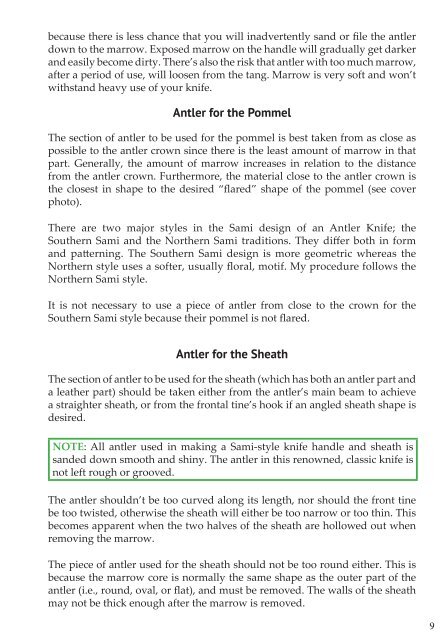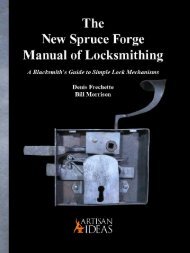Antle Knife: Making a Sami-Style Knife Handle and Sheath
This book’s detailed step-by-step instructions concern 1) selecting and preparing the material for the knife’s handle and sheath (e.g., the antler, the leather, the wood and the bark), then 2) using the material to build a classic and authentic antler knife the Scandinavian way. Most of the comprehensive and valuable instructions in this book, whose author lives in northern Sweden, concern the intricacies of working with antler, a subject in which the author has over 50 years of experience. The instructions will help you to avoid mistakes and to learn important procedures, tricks and tips so you can develop your own style. Although the author uses reindeer antler for this knife, he explains you could also use moose or caribou antler. The author says, “I hope this book will lower the reader’s learning threshold for working with antler, easing the knifemaker into this amazing hobby, and inspire readers to use their imagination and do something new”. Hardcover, 112 pages, 208 color photos and drawings, 10-in. x 7-in x .5-in.
This book’s detailed step-by-step instructions concern 1) selecting and preparing the material for the knife’s handle and sheath (e.g., the antler, the leather, the wood and the bark), then 2) using the material to build a classic and authentic antler knife the Scandinavian way. Most of the comprehensive and valuable instructions in this book, whose author lives in northern Sweden, concern the intricacies of working with antler, a subject in which the author has over 50 years of experience. The instructions will help you to avoid mistakes and to learn important procedures, tricks and tips so you can develop your own style.
Although the author uses reindeer antler for this knife, he explains you could also use moose or caribou antler.
The author says, “I hope this book will lower the reader’s learning threshold for working with antler, easing the knifemaker into this amazing hobby, and inspire readers to use their imagination and do something new”.
Hardcover, 112 pages, 208 color photos and drawings, 10-in. x 7-in x .5-in.
You also want an ePaper? Increase the reach of your titles
YUMPU automatically turns print PDFs into web optimized ePapers that Google loves.
ecause there is less chance that you will inadvertently s<strong>and</strong> or file the antler<br />
down to the marrow. Exposed marrow on the h<strong>and</strong>le will gradually get darker<br />
<strong>and</strong> easily become dirty. There’s also the risk that antler with too much marrow,<br />
after a period of use, will loosen from the tang. Marrow is very soft <strong>and</strong> won’t<br />
withst<strong>and</strong> heavy use of your knife.<br />
<strong>Antle</strong>r for the Pommel<br />
The section of antler to be used for the pommel is best taken from as close as<br />
possible to the antler crown since there is the least amount of marrow in that<br />
part. Generally, the amount of marrow increases in relation to the distance<br />
from the antler crown. Furthermore, the material close to the antler crown is<br />
the closest in shape to the desired “flared” shape of the pommel (see cover<br />
photo).<br />
There are two major styles in the <strong>Sami</strong> design of an <strong>Antle</strong>r <strong>Knife</strong>; the<br />
Southern <strong>Sami</strong> <strong>and</strong> the Northern <strong>Sami</strong> traditions. They differ both in form<br />
<strong>and</strong> patterning. The Southern <strong>Sami</strong> design is more geometric whereas the<br />
Northern style uses a softer, usually floral, motif. My procedure follows the<br />
Northern <strong>Sami</strong> style.<br />
It is not necessary to use a piece of antler from close to the crown for the<br />
Southern <strong>Sami</strong> style because their pommel is not flared.<br />
<strong>Antle</strong>r for the <strong>Sheath</strong><br />
The section of antler to be used for the sheath (which has both an antler part <strong>and</strong><br />
a leather part) should be taken either from the antler’s main beam to achieve<br />
a straighter sheath, or from the frontal tine’s hook if an angled sheath shape is<br />
desired.<br />
NOTE: All antler used in making a <strong>Sami</strong>-style knife h<strong>and</strong>le <strong>and</strong> sheath is<br />
s<strong>and</strong>ed down smooth <strong>and</strong> shiny. The antler in this renowned, classic knife is<br />
not left rough or grooved.<br />
The antler shouldn’t be too curved along its length, nor should the front tine<br />
be too twisted, otherwise the sheath will either be too narrow or too thin. This<br />
becomes apparent when the two halves of the sheath are hollowed out when<br />
removing the marrow.<br />
The piece of antler used for the sheath should not be too round either. This is<br />
because the marrow core is normally the same shape as the outer part of the<br />
antler (i.e., round, oval, or flat), <strong>and</strong> must be removed. The walls of the sheath<br />
may not be thick enough after the marrow is removed.<br />
9










